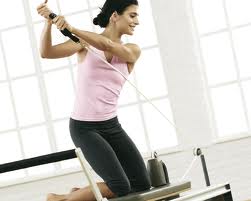
Seven physical performance factors for golf are posture, coordination, balance, functional strength, mobility, endurance, and stability. Pilates can create and improve all of these as well as range of motion, flexibility, alignment, concentration, and more.
Dina Voigt

Golf season is in full swing! (Pun intended!)
Any golfer will tell you that golf is a sport that is way harder than it looks. Golf requires the perfect balance between mobility and stability. It involves muscular strength, flexibility, concentration, and neuromuscular communication, among other things. It is said that on the moment of impact of a golf swing, compressive forces up to eight times one’s body weight are applied. (Corey, 2006) WOW! According to a National Golf Association survey in 2004, there are more than 26 million golfers in the United States alone. Yet it’s true that most golfers do not train for their sport like athletes such as soccer players or runners. It is also a known fact that golf stresses one side of the body more than the other, which leaves the body prone to back, hip, and shoulder injuries. With the imbalanced demand on the body, it is understandable how easily one can become injured if not conditioned specifically for the game of golf. Because the focus of Pilates is strength, flexibility, stability, and balance, there is no better training program for professional and amateur golfers to condition their body, improve their game, and prevent injury.
Statistics show that after age 30, golfers sustain an injury every three years. After the age of 50, the number of injuries increases to one per year! Approximately 60% of all amateur golfers experience injuries playing the game, (Metz 1999) and half of all professional golfers are forced to retire because of golf-related injuries. Golf injuries in amateurs are the result of overuse, poor swing mechanics and/or striking the ground with the club. (Corey 2006) The most common injuries for amateur male golfers are the low back (36%), elbows (32.5%), hands and wrists (21.2%), and shoulders (11%). Amateur women golfers have the highest incidence of injuries in the elbows (35.5%), low back (27.4%), shoulders (16.1%) and hands and wrists (14.5%) (Metz 1999).
While professional golfers tend to have fewer injuries than amateur golfers, they are not immune to injuries. Pro injury statistics read as follows: hands and wrists (29.6% men; 44.8% women), low back (25% men; 22.4% women), shoulders (11.4% men;7.5% women), elbows (7.3% men, 6% women) (Metz 1999). Due to the excessive hours of golf played by professionals, 80% of their injuries are caused by overuse. Twisting of the torso and hitting the ground with the club account for the other 20% of their injuries (Metz 1999).

Golf is a sport of asymmetry, which means both sides of the body work differently in golf and have specific jobs. Therefore both sides of the body need to be trained for the specific tasks they need to accomplish. Your conditioning program should include exercises that specifically focus on foot and leg alignment, core strength, joint and spinal flexibility, shoulder rotation, and arm, wrist, and hand strengthening.
Enter Pilates
As mentioned earlier, Pilates is the perfect conditioning program for correcting imbalances, improving your game, and preventing injury. It is well known that Pilates helps correct postural imbalances and strengthens the core; in addition, there are many more benefits gained from a Pilates conditioning program. Pilates breathing alone facilitates spinal rotation, helps with concentration, fires, and strengthens your core, which in turn assists strength and balance. Pilates rotational exercises help correct the imbalance caused by excessive rotation of the spine in one direction and help realign the core muscles. Pilates standing exercises focus on alignment and foot placement stabilizing the base of support. Weight shifting exercises help with balance.
Pilates principles and golf principles mirror each other. Seven physical performance factors for golf are posture, coordination, balance, functional strength, mobility, endurance, and stability. Pilates can create and improve all of these as well as range of motion, flexibility, alignment, concentration, and more. A complete Pilates conditioning program for golf will include a focus on lengthening tight muscles, decreasing multijoint tightness and strengthening weaker muscles for power on impact. Combined, these will improve the golfers game, prevent injury, and improve overall fitness. While your golf swing itself is something between you and your golf Pro; Pilates is everything you do for your body before you remove your club from your bag. Pilates training takes instruction and training, just like golf!

Pilates Principles as they relate to golf:
CONCENTRATION
Pilates teaches you where to place your focus for success in your game.
CENTERING
Pilates will get you past just patterning a movement and into understanding WHERE the movement comes from! Learn to swing from a strong center.
CONTROL
So much to think about! Re-educating your body with Pilates WILL help make your golf swing effortless. Think CONTROL, not momentum.
PRECISION
Focus on perfect alignment and movement quality will correct faulty movement patterns. Sloppiness in exercise carries over to sloppiness in other areas (your golf swing!)
FLOW
Developing core strength will help you connect your movements and improve your athletic ability. Think EFFORT with EASE!
BREATH
The Breath is NEVER held! Use the dynamics of breath to help you move consciously from a strong center into a powerful and controlled golf swing. Practice your Pilates breathing in the golf cart!!!!!
Taking this into consideration, you can see why it is imperative that an effective golf conditioning program must include specific training for each side of the body.
A complete, effective Pilates conditioning program will help you strengthen and balance your body to significantly improve your golf game while keeping your injury free.
Now that you know what Pilates can do for you and your Golf game, what are you waiting for? Jump into a Pilates Mat class at Fitness Incentive and start your journey to a stronger, balanced, injury-free body AND better golf game today!
Small group and partner training on Pilates apparatus are also available. Email dina@fitnessincentive.com for a free consultation and further information.
Sponsored Links
About the Author
Dina Voigt
Dina Voigt is the Manager of Fitness Incentives Pilates and Yoga programs. She is a PMA-certified Pilates trainer, a certified Yoga instructor, a Personal Trainer, Group exercise instructor, and Cycle instructor.
Contact her at dina@fitnessincentive.com with any questions or for further information.

